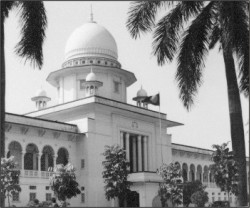Law opinion
Judiciary's journey to independence
Kazi Alauddin Ahmed
 The legacy of a century or more thus came to an end. November 01, 2007 went down in the annals of Bangladesh as a golden day. The long cherished desire of the common people of the country to have an absolutely independent judiciary became a reality. What necessitated urgent implantation of such a radical change in our legal system can be a very pertinent question one can ask. To find an answer to it we shall have to allow ourselves some moments to reminisce over the past situations observed in this part of the world, precisely in the pre-partition Indian sub-continent during British rule.
The legacy of a century or more thus came to an end. November 01, 2007 went down in the annals of Bangladesh as a golden day. The long cherished desire of the common people of the country to have an absolutely independent judiciary became a reality. What necessitated urgent implantation of such a radical change in our legal system can be a very pertinent question one can ask. To find an answer to it we shall have to allow ourselves some moments to reminisce over the past situations observed in this part of the world, precisely in the pre-partition Indian sub-continent during British rule.
Two distinguished institutions, viz. the magistracy and the judiciary representing the legal system in British India used to enjoy universal respect and credibility of the people at large. The district magistrate and collector used to be the head of the civil administration in the district which included all the magisterial courts. The District and Session Judge headed the judiciary part of the whole administration. The magistrates looked after those cases falling under the purview of the Criminal Procedure Code (CrPC). Deputy magistrates and sub-deputy magistrates used to sit in these courts for disposal of criminal cases mostly. Besides, there used to be other kinds of magistrates designate -- lawyer magistrates and honorary magistrates or honorary deputy magistrates. They belonged to group of lawyers, often non-practicing and the last named represented mostly the feudal aristocracy and social elite. At the end of their term they were awarded titles like Khan Bahadur, Khan Saheb, Rai Bahadur, Rai Saheb etc.
In the sub-divisions of yesterday (today's upazila) the administrative head used to be designated as sub-divisional officer, briefly SDO. Concurrently there were Sub-divisional Magistrates (SDM) looking after the criminal cases mostly. On the judiciary there were sub-judges accountable to the District Judge.
So, these were roughly the organisational structures of the magistracy and judiciary in the British days and continued after partition of India. The people who represented these two organs of the legal system had to get through written examinations conducted by the Public Service Commission. There was a strange coincidence that those who sat for such competitive examinations wielded immaculate scholastic faculties. And in the majority cases they belonged to highly enlightened families, some representing families of intellectuals, eminent teachers, educationists and feudal lords of those days. There was an indirect and unwritten rule followed by the selectors at the instance of the British masters to take in the qualified candidates representing aristocratic families alone. Undemocratic though, the selectors had to go by the so-called 'blue blood' philosophy to ensure good performance from the incumbents in all these positions.
The status of the two wings of the legal system obtaining in the bygone years is alluded to only for affording ourselves an instant comparison with today's situation. Following the partition of India the civil service of Pakistan, organised anew, maintained the old, replicable tradition without allowing any transgression of the values it upheld meticulously. Both the criminal and civil courts enjoyed relative freedom from touts, sychophants and briefless lawyers thriving on crooked means and exploitation of the innocent, uneducated clientele within court premises.
The scenario started taking perverted looks with the passage of time. Large-scale infiltration aided by crude politicians with direct or indirect support from the power centre soon commenced creating devastating impact on the whole legal system. In particular, the magistracy reporting to the executive part of the government, precisely the political party in power rapidly aggravated the situation to the worst. Belated though, the realisation of an absolutely independent judicial system gained rapid momentum. Mazdar Hossain vs the State case of 1999 was indeed the turning point and November 01, 2007 added a new page to the history of Bangladesh. The long cherished desire of the people of the country became an irreversible reality. We have now a fully independent judiciary free from all intrusive intervention of the exertive part of the government.
It is premature to make any comment on the prospects and possibilities of the newly installed independent judiciary. Everything will depend on the personal integrity, clear understanding of the thematic value of the new system, staving off the tauts and crooks from the court premises once for all. We have now a sacred, noble and inalienable mission to fulfil. Let us hope for the best.
The writer is management consultant.